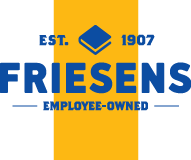December 03, 2021
Scaling Images
By Brad Schmidt – Colour Tech Support Specialist
There are often different approaches that can be taken when preparing a book. When using InDesign or Photoshop there are often multiple ways to achieve the end result. In speaking with different users of Photoshop, you will find that there are many different approaches for how to solve a specific problem. Each user brings their own preferences into the process. For some, when making colour adjustments the natural tools are Curves or Levels. For others it may be Brightness/Contrast or Hue/Saturation. The end results may be similar, but the path to get there can be quite different.
Even something as simple as which file type to choose when saving a file can be a topic of heated discussion. When I started working in prepress, there was a strong focus on only supplying images in TIFF or EPS format. Over the years, this requirement has softened and I often see images provided in other formats. With the adoption of InDesign, we saw this shift to the use of more image formats. Photoshop files in PSD format started to become more common. The ability to maintain the adjustment layers in the original images became a compelling reason to consider keeping images in PSD format. The drawback of taking too much disk space is less of a deterrent as storage space has become less expensive.
Even the endless debates about the merits of supplying images in JPEG format have largely subsided. In the past it was rare to see images supplied in JPEG format. I can even remember that JPEGs were often converted to TIFF in many workflows. Today we see images provided in a variety of formats, including TIFF, JPEG, PSD, EPS, or even PDF.
When deciding on the steps to prepare a project for print there are often various factors that need to be evaluated. There is usually a balance between speed, flexibility, and quality. Decisions made early in a project will likely favour one of these qualities at the expense of another. I often see this in the debate about which is better, working in the RGB or CMYK. These values come into play in this process, as one workflow offers more flexibility and the other offers more control. Each has its place, but the goals of each project need to be considered when navigating which image format, colour space and software will be used to construct a project.
Another process that comes up for discussion is the sizing of images. When images are placed onto the page, InDesign offers a variety of tools to manipulate the image within the page layout. It is very common to crop images in InDesign – to only use a portion of the photo. Images can also be rotated or flipped. InDesign also provides an option to scale the image within the page layout. The other option is to open the image in Photoshop and adjust the size there. This is one of those areas where it is much more convenient to adjust the size in InDesign while working on the page layout. Flexibility would definitely be an advantage to adjusting image size in InDesign, but is there a quality difference? Both Photoshop and InDesign are Adobe products, so one might expect the sizing methods to be the same.

To test this, I took an image and placed it in InDesign and reduced the size significantly, resulting in an image about 10% of the original size. The effective resolution for this image increased way beyond the recommended 300 ppi we use for printing. I took the same image and reduced the size in Photoshop to 10% and made sure that the final resolution was 300 ppi. This allowed me to place the images side by side. I then exported the page to PDF using our recommended PDF settings, which downsamples images to 300 ppi for images that are above 400 ppi. The image that was sized in Photoshop converted to PDF without any change, while the image that was scaled in InDesign was downsampled to 300 ppi using the engine built into InDesign.

When comparing the two methods, there is a difference. It is not a huge difference, but there is a difference. Using Photoshop, the results are an image that maintains more detail than the image that was scaled using InDesign. By zooming in for a closer look we can see that the InDesign image has a slightly softer appearance.

Depending on the project, this could be reason enough to take the images back into Photoshop.

Since we are already in Photoshop to perform the sizing adjustment, we can also apply an Unsharp Mask to further enhance the detail in the image. By resizing in Photoshop and applying the Unsharp Mask, the detail is further enhanced. The clarity of the text on the circuit board and the texture of the chip surface are clearer. Excessive application of the Unsharp Mask can result in halos along the edges.

In the end it really comes down to the requirements for each individual project. Are the quality requirements for the project such that the extra steps to edit in Photoshop will be worth it? In many cases there may be a balance, where small percentage adjustments can be done safely in InDesign with little sacrifice to quality. For larger scaling adjustments, the extra steps may be worth the effort. As a guide, we usually recommend a scaling of more than 20% up or down to be considered for a Photoshop adjustment.







